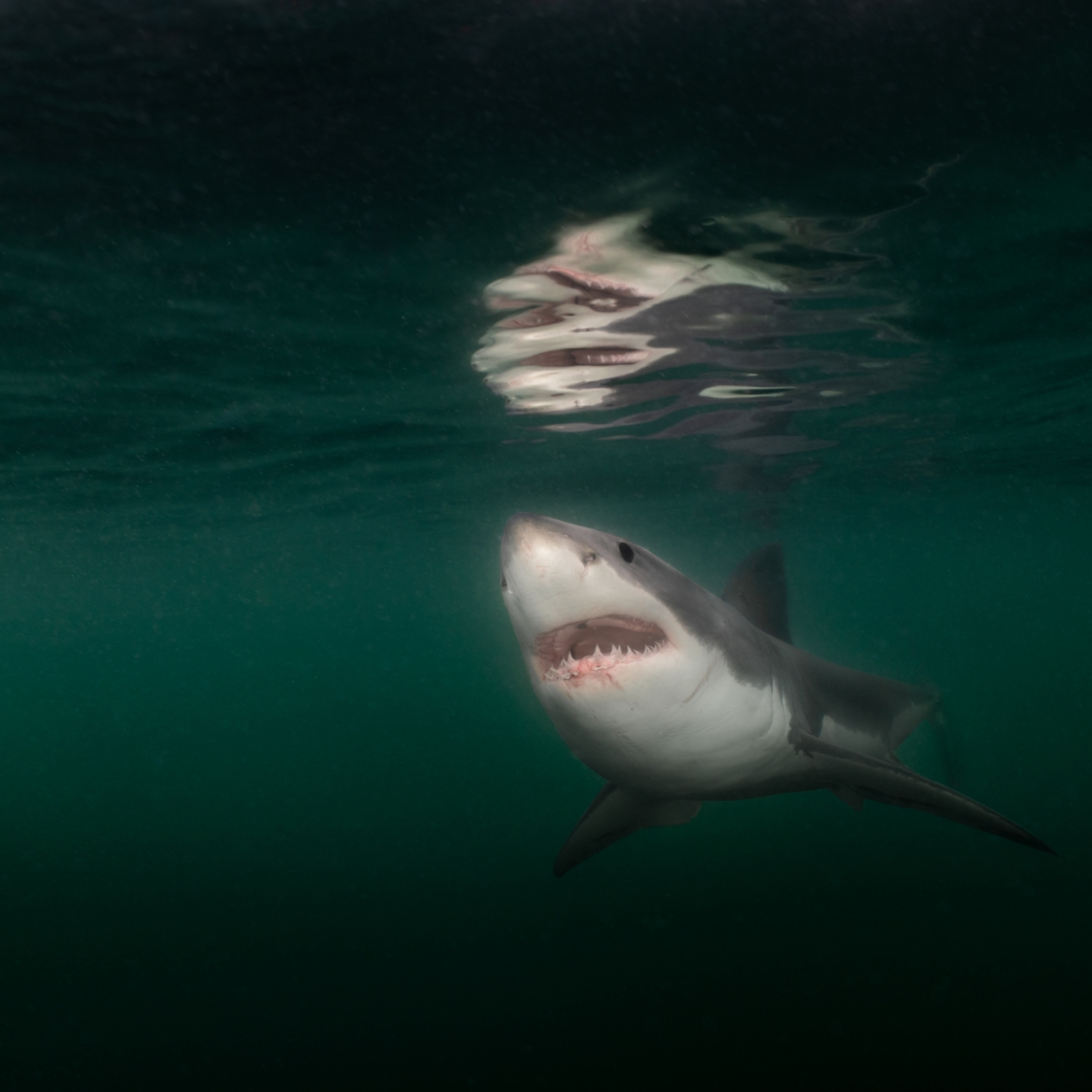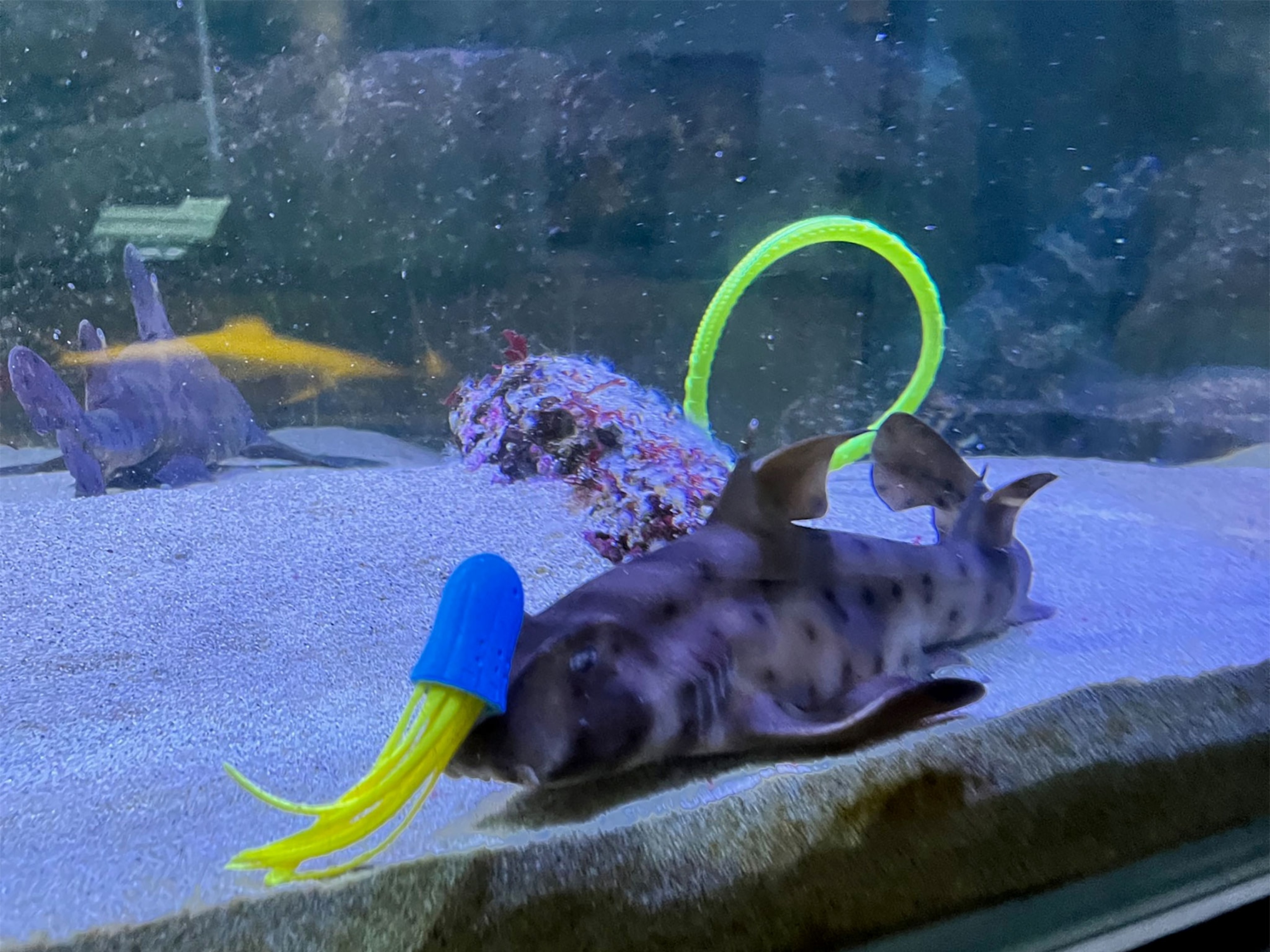A female great white shark has completed the first documented round-trip ocean crossing by a shark, swimming farther than any other known shark, according to a new study.
Nicole, as the shark is being called, traveled from Africa to Australia and back—a total of 12,400 miles (more than 20,000 kilometers)—in nine months. The feat also set a second record: fastest return migration of any known marine animal.
The shark's approximately 6,900-mile (11,100-kilometer), 99-day swim from South Africa to Australia was tracked with an electronic tag that had been attached on November 7, 2003. The device had been set to pop off on a specific date in late February 2004.
After floating to the surface, the tag told a satellite the details of its journey. The information was then automatically relayed to scientists' e-mail accounts.
On the day the tag was scheduled to transmit its data to the satellite, New York-based shark researcher Ramón Bonfil eagerly booted up his computer to get the scoop.
"When I opened the Web site and saw the map with the tag transmitting from the coast of Australia, I just couldn't believe it," said Bonfil, who works for the Wildlife Conservation Society (WCS). "It was exactly what I wanted one of the sharks to do."
The news only got better: Six months later zoologist Michael Scholl called Bonfil from South Africa and said the shark had returned from Australia.
Scholl, the founder of the White Shark Trust, had identified the shark's unique fin markings in a series of photographs of Nicole—named after Australian actress and shark lover Nicole Kidman.
"We never imagined it would be back to South Africa so quickly or that we would ever find out it was back," Bonfil said.
The details of Nicole's big swim, and those of several other South African sharks will be published in tomorrow's issue of the journal Science.
"It's just fantastic data," said Robert Hueter, director of the Center for Shark Research at the Mote Marine Laboratory in Sarasota, Florida. The findings, he added, advance shark biology by showing that the fish are more than just "ocean nomads that roam about" aimlessly.
Shark Biology
In recent years genetic data has suggested that some male great white sharks migrate between South Africa and Australia. But such a continent-to-continent swim had never been documented.
Starting in August 2002, the WCS's Bonfil and his colleagues began a long-term tracking project in hopes of answering basic questions about great whites: Where do they hang out? When do they migrate? Which ones go?
One surprising find is that great white shark populations have physical connections with populations half a world away. But perhaps the most surprising find, at least for shark experts, is that these connections appear to be made by females, if not both sexes.
"This opens up a bunch of new questions about shark biology," Bonfil said. "We don't know why these sharks travel all the way to Australia—if it is for feeding reasons or reproduction. And so now there are more questions than answers."
Scholl's photo-identification records track the South African great white population. They show that since 1999 Nicole has appeared in her South African home waters only between June and December. This suggests that her migration may be a regular occurrence.
The tracking data also show that sharks—males, females, adults, and juveniles—make frequent migrations. Some journeys are as long as 1,200 miles (2,000 kilometers) and generally take the sharks up and down the South African coast. Many of them return to the same spot off the Cape of Good Hope, near Africa's southernmost point.
Mating Game?
According to Bonfil, the coastal migrations are most likely food related—the sharks go north to abundant fishing grounds.
So why did Nicole make the mad dash to Australia and back? Bonfil speculates it was about a mate.
South Africa has ample seals, sea lions, overwintering whales, and fish to prey on, he said. "So I would doubt—though I have no proof—that [Nicole] went all the way to Australia to feed on something," Bonfil said.
On the other hand, Nicole measures 12.4 feet (3.8 meters) long. This is smaller than the 14.8 feet (4.5 meters) at which great white sharks are believed to reach sexual maturity, suggesting that she's not ready for a mate.
Michael Domeier is a marine biologist and president of the Pfleger Institute of Environmental Research in Oceanside, California. "Feeding may be the more likely candidate in this case," he wrote in an e-mail.
But the question is open, according to Domeier. "Perhaps individuals begin to make excursions to mating areas prior to reaching full maturity—let's call it a practice run," he said.
Celestial Guide?
So how did Nicole know where she was going? And what led her back to the very location off South Africa where she was originally tagged?
"The idea that this is happening through some kind of roaming function or happenstance or by following a current is hard to accept," Hueter of the Mote Marine Laboratory said. "You really have to believe these animals are navigating in a purposeful way."
The WCS's Bonfil and his colleagues suggest that the sharks, which are known to have eyesight sensitive to dim light, use visual cues, such as the location of the sun or moon, to navigate.
Data from Nicole's tag show that she spent more than 60 percent of her time swimming right at the surface. She did frequently dive to great depths—sometimes as deep as 3,000 feet (900 meters). Her path, however, was nearly straight.
"We speculate that probably it is using its eyes to find its way to Australia, and the obvious means of doing this is the moon and sun," Bonfil said.
Alternatively, sharks could use Earth's magnetic field to orient themselves, as other animals have been shown to do, Domeier said.
Whatever their method, great white sharks may be navigating dangerous waters. Their newly discovered ocean-crossing ways take the sharks into areas that are less regulated than coastal areas.
"Nicole has shown us that ... wide-ranging white sharks that are nationally protected in places such as South Africa and Australia are much more vulnerable to human fishing in the open oceans than we previously thought," Bonfil warned in a WCS press statement.








